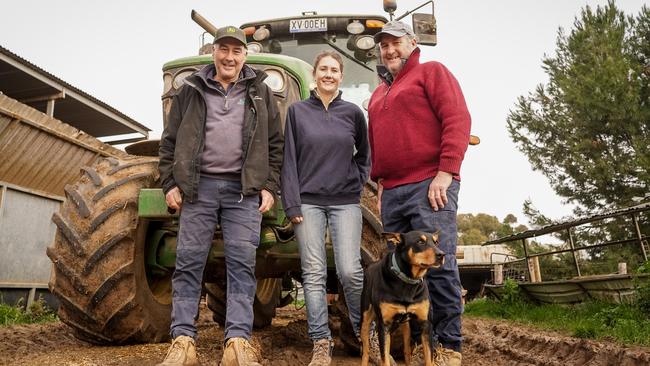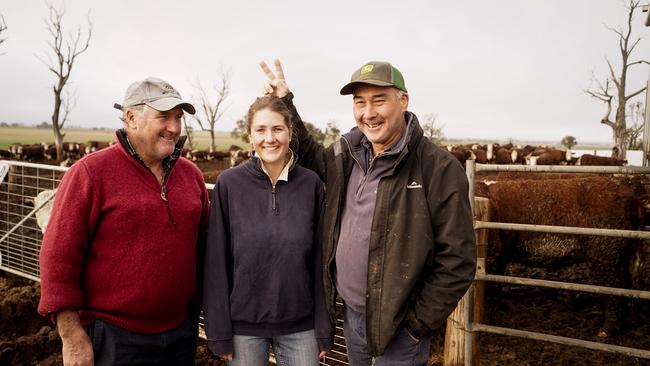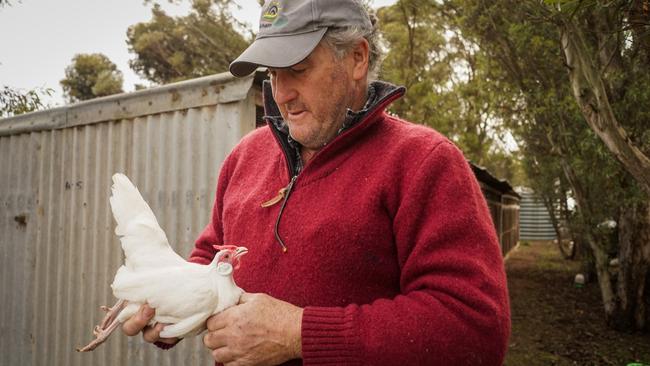‘It’s a team effort’: Two generations building a farm enterprise
The Wimmera’s Wheaton family have harnessed timing, succession, and a diverse skillset to create a booming self-sufficient farming enterprise.
The Wimmera’s Wheaton family have harnessed timing, succession, and a diverse skill set to create a booming self-sufficient farming enterprise.
Brothers and mixed farmers Brett and Dean Wheaton manage cattle, sheep and cropping with four of the third generation on the farm, Harry, 24, Diana, 24, Angus, 22, and Wallace, 19.
With their home base northwest of Nhill, they have nearly 9000ha across Yanac South, Netherby and Telopea Downs, with 2200 Merino ewes, 400 Poll Hereford cattle and a 2000ha cropping program, alongside Dean’s Rosecomb chicken flock.
They also manage a small Merino stud, Peechember West Merinos.
This year they have nearly doubled their canola area sown and are also growing wheat, barley, vetch and beans.
About 1600ha of their crops are harvested and sold, with the remainder as vetch for feed.
Their moisture profile is currently sitting at 93 per cent “all the way down”.
They have a weather station with a probe monitoring soil moisture at all times, with their agronomist soil-testing before sowing.
They average 350mm of rain annually on heavy red bulloak to black self-mulching soil.

Brett said they had recorded about 27mm of rain for July.
“We took a risk this year,” he said.
“Last year was a big wheat year, and a big barley year. This year we thought with the moisture, we had a lot of summer rain, so we sowed a lot of canola.”
He said there had been enough rain now for the amount of sunshine, and hoped it would remain warmer to encourage growth.
“We can see the legumes just starting to kick now, we’ve put the zinc out and we’ve done everything we can,” he said.
He said they expected roughly half the canola tonnage to their 2023 season, with about 2-2.5 tonnes a hectare at best this year.
“We needed 10mm in the last week of April and we could’ve pencilled in a bumper canola year, but we never got it.”
TIGHT MANAGEMENT
The Poll Hereford heifers are joined by artificial insemination and allow three cycles to be in calf, one by AI and two cycles naturally. If they aren’t in calf they sell to Coles to retain their calving pattern.
They join heifers at 14 months to begin calving on March 5, and cows start on April 1 each year.
“For our cows in the scrub, it keeps our calving pattern in a tight pattern,” he said.
They prioritise low birth weight and strong 400-day growth rates in their herd, to breed cattle to finish in the feedlot.
Dean said they run their all stock at Telopea Downs, before moving the calves to Yanac South for feedlotting.
They start selling in late June, and sell between 300-400 vealers annually direct to Coles.

Their sheep flock start lambing at Telopea Downs from the end of March to early September, with a 100-110 per cent scanning rate.
“If there’s a downside to the system, it’s that we’re always busy,” he said.
Dean said they were currently full-time feeding, and were feeding their cattle at Telopea Downs, which was unusual for their program.
“At the start of this year I thought we had about two years’ supply of hay, but I was delusional,” he said.
Brett said they were facing a challenging season, like many Victorian farmers.
“Out of 10 years, you make your money out of three and the other seven years you survive. But this year is tough,” he said.
TEAM EFFORT
Brett is also the Nhill Graingrowers president, and said he hoped to encourage generational farmers to move through the system.
“We want to focus on our generational farmers. We’re a closed shop, everything we do is for our internal network,” he said.
“Everyone does their role, but when we’re shearing or weaning lambs, or fencing, it’s a team effort.”
The family are currently planning for succession, after setting up their trusts.
Dean’s daughter Diana, who is one of four children on the farm, returned to the farm after working at Hassad Telopea and studying at Marcus Oldham College in 2020.

She completed a placement in New England, NSW, in 2021 before she returned to the family farm.
“I’ve experienced working with different people and in different climates,” she said.
“The attraction was to come back and work with the family and build up our business.”
She joined the Birchip Cropping Group, and has a strong focus on bringing innovation onto the farm.
Brett said all of their GPS systems were “as good as you could get”, but hoped the market would offer a master program that incorporated each part of the farm.
Everything is sown and sprayed with GPS on the farm, and any tractor can be GPS controlled.
ELITE WOOL
They recently bought a Nareeb Nareeb Merino ram with elite wool at the Australian Sheep and Wool Show, Bendigo, to AI 150 ewes and use naturally in the Merino flock.
Dean said they selected the top 1200 ewes by wool and body conformation to use with Merino rams, while the remainder would be joined to Border Leicester rams.
The first-cross lambs were sold to a breeder’s market at Naracoorte.
They cut hay for their own feed, maintain green fallow, and use bean stubbles to fatten their first-cross lambs.
They have recently made some on-farm investments, by covering three sets of sheep yards with roofing to avoid working in the elements.
“We got sick of playing in the mud so we decided to cover our stockyards,” Dean said.
“You don’t know how good the sheds are until you’ve got them.
“You’re out of the sun, rain, and wind, it’s just so good.”
Dean also had sheds to house his feathery flock of Rosecomb chooks, which he described as an “escape”.
At peak capacity, Dean kept up to 200 in his sheds at one time started his own Rosecomb show, which was held annually for a decade, collecting people from NSW, eastern Victoria, and South Australia before the Covid-19 pandemic.
He said he would often give away Rosecombs to help promote the breed and help others improve genetics.
“It’s an art form with genetics,” he said.




